Delhi, India—Bangla Sahib Gurdwara, a Sikh temple in central Delhi, was once a Maharajah’s palace. This impressive building has gold domes and is surrounded by acres of marble plazas, as well as a vast pool of water, a dip in which is thought by Sikhs to cure all ailments. I spent a week here at the gurdwara, where I had volunteered to cook at what is known the temple’s langar, or an enormous soup kitchen for the poor that operates 24 hours a day, 7 days a week.
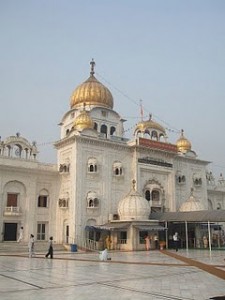 Showing me about on my first day was a soft-spoken young woman named Sukwinder Kaur, who was dressed in a sherbet pink sari. She informed me that breakfast, lunch and dinner are all served every day, though officially the kitchen never closes, and someone who is hungry can get a meal any time. As a result, she said in passing, the soup kitchen feeds upwards of 20,000 people a day, “Excuse me,” I interrupted, thinking either I’d misheard, or that speaking in English, rather than her customary Hindi, the young woman had misspoke. “Don’t you mean 2,000?”
Showing me about on my first day was a soft-spoken young woman named Sukwinder Kaur, who was dressed in a sherbet pink sari. She informed me that breakfast, lunch and dinner are all served every day, though officially the kitchen never closes, and someone who is hungry can get a meal any time. As a result, she said in passing, the soup kitchen feeds upwards of 20,000 people a day, “Excuse me,” I interrupted, thinking either I’d misheard, or that speaking in English, rather than her customary Hindi, the young woman had misspoke. “Don’t you mean 2,000?”
“No. 20,000. Sometimes more.”
I was stunned. And, I now like to think it was because this number put me into a temporary state of shock that I made my next, altogether clueless, request. “Is there some sort of class, or maybe an instructional video, to show me how I should go about working in the kitchen?”
Sukwinder was obviously confused by my question, as if I’d asked if there were an instructional video to teach me how to breathe. “Anyone can cook,” she replied. “The only thing required of you is that you wash your hands first. You must also be barefoot.”
Food is an important part of the Sihk religion, and feeding poor people is central to their belief. In fact, at all Sikh temples, or gurdwaras, there is a langar, operating round the clock to serve nutritious vegetarian fare, to anyone who arrives, be they rich or poor, Sikh, Muslim, Hindu, Christian, or Jew. Here, no distinction exists between castes, so that Brahmins sit with the Dalits, or “untouchables.” When American hippies first discovered India—subsequent to the much-ballyhooed arrived of The Beatles in 1968 at Rishikesh—these penniless seekers who followed in the Fab Four’s wake often ate their meals at gurdwaras.
Shortly after my arrival in Delhi, I met with a laywer named Parvinder Singh, a Sikh, who generously explained his religion to me, and helped me understand what I would see at Bangla Sahib Gurdwara’s 24-hour soup kitchen. I had arrived, he told me, at a most fortuitous moment, and a time of tremendous excitement in the Sikh community: it is the 300th anniversary of the Guru Granth Sahib which is the Holy Scripture for Sikhs.
Sikhism began in the 15th century, as a push back against Muslims who were forcibly trying to convert Hindus to Islam. In Sikhism, there are ten historical gurus who are revered, and the first was Guru Nanak. Once you recognize him, you begin to see Guru Nanak’s picture all over Delhi. To my eyes, he looks like Santa Claus, only he’s wearing a mustard-yellow turban.
Nanak’s birthplace was in Punjab, once part of India but, since Partition, now in Pakistan. Born in 1469, Guru Nanak grew up to become a missionary, spreading his message of tolerance and love while walking the subcontinent’s entire length and breadth, from Tibet to Sri Lanka, Burma to Iraq. Until that time, Hinduism was the religion of the masses, but Islam was the religion of rulers. The much-told story has it that one day, Nanak’s father, a rich businessman, gave his son 20 rupees, or gold coins—then, quite a sizable sum—and told him to turn a profit with it.
 These coins jingling in his pocket, he met a group of sadhus (holy men) who hadn’t eaten in some time, so Nanak spent the money to buy them food and to satisfy their hunger. Back at home, when his Dad quizzed Nanak on his investment strategy, Nanak replied that he’d performed the best business deal possible.
These coins jingling in his pocket, he met a group of sadhus (holy men) who hadn’t eaten in some time, so Nanak spent the money to buy them food and to satisfy their hunger. Back at home, when his Dad quizzed Nanak on his investment strategy, Nanak replied that he’d performed the best business deal possible.
“The twenty coins have multiplied,” said Parvinder. “It is out of the grace of this experience that today’s practice of langar, or feeding the hungry, has grown.”
Parvinder Singh is quick to point out that it is not just at the Gurdwara Bangla Sahib in Delhi that langar is performed, but at all Sikh temples, including those in the United States. (He suggests I go see what happens in Richmond Hill, Queens, just outside Manhattan, for instance.) At Amritsar, in the northern part of India, there is a machine that can make up to 10,000 chapatis an hour, but they don’t use it too often, as there are so many people eager to do volunteer work at the city’s famed Golden Temple, the bread is all rolled out by hand.
Really?
“Oh, yes. Prayer alone will not bring me to God. Knowledge alone does nothing. It is the practice of what we have learned that is important,” Parvinder says. “When the people cook this food, what’s called the parshad, they say prayers—they put God’s blessing into the food. When we eat the food, this is why it tastes different, and is so satisfying to us.”
Not only that, but parshad is calorie-free.
Sikh mothers are nearly militaristic in their compulsion that you must put some of their food in your mouth. It is a grave insult not to.
Or, so I learn when I leave Parvinder’s house, head off towards the gurdwara, and find myself stuck in a 300th anniversary parade that has choked traffic to a standstill in this part of Delhi. We’re going nowhere, so I get out of the car and go look. All along the parade route, free food is being served everywhere, and people are urging me to eat. In short order, I am encouraged to eat deep-fried samosas, a plate of lentils and rice, almond paste, ice cream, biscuits, spicy popcorn, almond paste, cotton candy, three mangos, and still more almond paste. On top of all this (burp!), one woman, dressed in a sari that is emblazoned with swirling pink paisleys, is particularly vehement in her insistence that I eat some of her lamb kebabs.
I laughingly try to refuse, explaining that I don’t want to get fat.
“No matter how much you eat of parshad, you will never gain weight,” she replies. “Even a diabetic person can eat unlimited quantities of sweets, but if they are parshad, it will not affect them.” She is not joking.
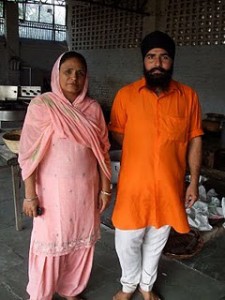 Following the directions of Sukwinder Kaur, my guide, I remove my shoes, and we walk together over a dirt, rock and rubble-strewn courtyard, through a crowded parking area, and to an open-air shed, more like a hangar, where dozens of people are working away. (I later learn this whole area is a parking garage under construction.)
Following the directions of Sukwinder Kaur, my guide, I remove my shoes, and we walk together over a dirt, rock and rubble-strewn courtyard, through a crowded parking area, and to an open-air shed, more like a hangar, where dozens of people are working away. (I later learn this whole area is a parking garage under construction.)
Sukwinder introduces me to her cousin, Biswajit Singh, a 29-year-old man with whom I will spend many hours in the days ahead. His dark beard dangles down to about where his sternum must be. He is the boss and the only paid employee in the whole kitchen. When we meet, he smiles brightly, as if he doesn’t have a care in the world. He speaks Punjabi and Hindi, but no English. Sukwinder translates for me, making me incredulous at the calm bliss of her cousin’s smile. Either Biswajit is a very holy man, or they have really, really good anti-depressant pharmaceuticals in Delhi.
Every day, Biswajit knows 20,000 men, women and children will arrive at his doorstep, hungry. They will line up for hours in the hot sun, eventually being herded into a queue that forms them into groups of 600 at a time. Whereupon, they will rush forward, hunker down to sit in one of three long lines, with a tin plate on the floor in front of them, waiting anxiously for the food Biswajit has prepared for them to eat. I might add that this is probably the only thing these poor people will eat all day.
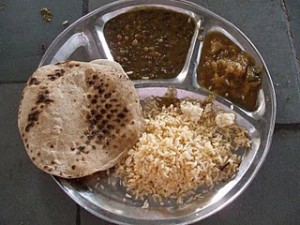 As if this isn’t daunting enough, Biswajit doesn’t know from one day to the next what he will be cooking, or which foods will be on hand. This kitchen, you see, like most kitchens in India, does not have any refrigerator. Instead, the vegetables, grains and beans (no meat is served) are primarily donations that arrive on their own mysterious time table, throughout the day.
As if this isn’t daunting enough, Biswajit doesn’t know from one day to the next what he will be cooking, or which foods will be on hand. This kitchen, you see, like most kitchens in India, does not have any refrigerator. Instead, the vegetables, grains and beans (no meat is served) are primarily donations that arrive on their own mysterious time table, throughout the day.
For instance, while Biswajit, Sukwinder and I are talking, a truck loaded with what appears to be 1,000 heads of cauliflower pulls up—a gift from some anonymous Sikh who suddenly thought this morning, “Maybe I’ll send a little something over to the temple.”
“You didn’t know this was coming?” I ask Biswajit, and Sukwinder translates.
His answer, given in Punjabi, comes back. “No, it is a surprise. A good surprise!” At the end of his comment, I’d heard him say something that sounded like “Sut Sri Akal.” When I ask Sukwinder what this meant, she smiles. “God is good,” she translated.
All the people who will now unload the truck of cauliflower, cut it up, cook, serve, and wash the plates it is served on, are also volunteers, who arrive on their own capricious schedule. There is no “org chart,” no “directory of staff.” Every person—now, including me—who is working in this kitchen just decided today, “Oh, I guess it is time to spend an hour or two over at the langar.” Think of trying to feed your family this way, and then, imagine you’re having 20,000 surprise guests.
Was I ready to start? Sukwinder asked me. Yes, I said, what would you like me to do?
“Oh, just jump in wherever you like,” she replied.
Biswajit was off unloading that cauliflower truck. With this being the 300th anniversary of the Guru Granth Sahib, Sikh pilgrims were arriving from all over the world, and Sukwinder was busy with their needs. She’d been gracious to give me these few minutes. I was now, very much, on my own. I was the only American, the only white face, and no one around me spoke any English.
O.K., Stephen. You asked for this. Figure it out, pal.
Looking about, I see lentils being cooked along one long, brick wall. They are stirred in copper cauldrons the size of Jacuzzi bathtubs, and over open flames stoked by firewood. This looks exciting, and eventually, I’ll pitch in over these fires.
In my apprenticeship afternoon, though, I opt for something less challenging when I see two slate troughs, low to the ground, each the size of a children’s swimming pool in a public park. A pair of women sit at either end of each trough, behind small mountains of bread dough. They pry off a hunk, separate it into smaller pieces, roll these into balls, and toss them out, in turn, to dozens of other people, sitting at low benches along the troughs’ long sides. Each person is busy rolling out balls of bread dough, into flat disks, which they stack up like pancakes. These are the type of Indian bread called chapati.
What if I weren’t here today? What if I hadn’t come to Delhi? Who’d chop the vegetables then, huh? But I had, and here I was.
There are many small rolling pins lying about. I’ve made a pie crust or two in my time; I can do this, can’t I? Nonetheless, sitting down at the chapati-making trough it seems to me, at first, like everyone else knows what they are doing, and my efforts are a hindrance. I see Indian women take a dough ball and with a couple of deft motions, flatten it out into a perfect patty. I’m not nearly this agile, but I put my head down and try to silence the voices of self-reproach in my mind.
This was my world for five days. I rolled thousands of chapatis. I learned to cook them on a wood grill. I stirred those copper “Jacuzzis” full of lentils, and banked the fires beneath them. I sorted, cleaned and chopped countless vegetables sitting outdoors, under a rippling tarpaulin, with piles several feet high of potatoes, plum tomatoes, zucchini or ginger root spread about me. It was up to me to pick over, clean, and chop every last piece of produce I see. Often there’s no one to help me. Everyone else is busy doing something else. How is this possible? What if I weren’t here today? What if I hadn’t come to Delhi? Who’d chop the vegetables then, huh?
But I had, and here I was.
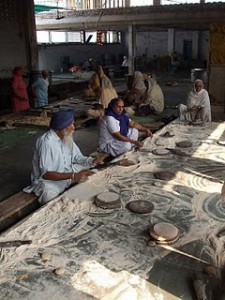 Every morning, I would wake up early and head over to the kitchen area, barefoot, my soles by now quite black. I would toss back a couple cups of very hot, very sweet chai tea. For the next 14 hours, from 8 a.m. to 10 p.m., I’d labor away and worked harder, I think, physically, than just about any other time in my life.
Every morning, I would wake up early and head over to the kitchen area, barefoot, my soles by now quite black. I would toss back a couple cups of very hot, very sweet chai tea. For the next 14 hours, from 8 a.m. to 10 p.m., I’d labor away and worked harder, I think, physically, than just about any other time in my life.
Strolling through the vast kitchen was an ever-rotating cadre of sadhu, or holy men, who wandered about praying to themselves, until at some inner prompting of their own, they felt the need to shout at the top of their lungs. (I got used to it.) Hours would pass and, once, a whole day, where I didn’t hear a word of English, and every interchange I had was done strictly through pantomime. There was one notable exception, though, when I was startled to hear my own language. Remembering it still makes me flush with shame.
I was swinging a heavy pot full of lentil stew, working my way down the line of hungry people seated on the floor, glopping a spoonful onto the person’s outstretched tin plate. Or, maybe I was balancing a wicker basket full of chapati at my hip, as I dispersed pieces of flat bread. I had to move quickly, and most of the diners would become a blur. Sometimes, though, I would look up and see a face smiling at me, and I would feel a flood of happiness at what I was doing. Gradually, I began to allow myself the occasional human touch. I would squeeze an old woman’s shoulder encouragingly, or tickle a child’s ear. I hoped, somehow, that this made the whole interchange a little more human.
I’d been doing this for a few hours one afternoon, when another volunteer, a guy with a brilliantly red turban, suddenly jerked on my elbow and pulled me aside.
Speaking in plummy English, his accent sounding like he’d just stepped off a wide green lawn of Oxford or Cambridge, he said to me, “My friend, it’s all very dear these compassionate caresses I see you are giving, but any physical contact here is quite forbidden. Many of these people have AIDS, leprosy, tuberculosis, or something worse. And, have you even considered that you, too, might have germs of your own you could pass on to them? Now, go wash your hands, and then get back to work!”
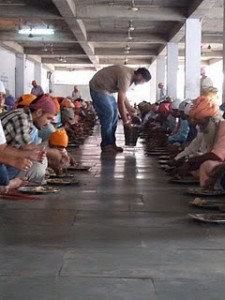 He pushed me towards a door in the kitchen, where there was a bathroom I didn’t even know existed. Here, I spotted the first and only piece of soap I saw in my entire time at the Sikh temple in Delhi. As I scrubbed my hands, I felt a choke of anger rising in my throat, not for the man who’d reprimanded me, but for myself. I was indulging in Mother Teresa fantasies, and had gotten totally busted for it. I felt quite a fool.
He pushed me towards a door in the kitchen, where there was a bathroom I didn’t even know existed. Here, I spotted the first and only piece of soap I saw in my entire time at the Sikh temple in Delhi. As I scrubbed my hands, I felt a choke of anger rising in my throat, not for the man who’d reprimanded me, but for myself. I was indulging in Mother Teresa fantasies, and had gotten totally busted for it. I felt quite a fool.
And then, I had another thought. Learning how to be of service to others takes some trial and error. Maybe, one has to allow oneself to be made a fool of—that’s just part of the deal. It’s a hard part, though, and it is why many of us probably hesitate to jump in anywhere, and improvise a way to “help out.” No one intends to be selfish or consciously sets forth to neglect the needy. For those of us fortunate few, however, there is guilt and paralysis caused by the unfairness of our blessings (why me? Not him?) Often there seems to be no graceful way to connect with the needy. When we do, it is easy to feel clumsy, ridiculous and patronizing. Writing a check is antiseptic. When we attempt some dirty work ourselves, however, we may get soiled—or even scolded—in the process.
My hands scrubbed clean, I went back to serving lentils. I didn’t touch anyone anymore. As I thought about it, I was glad the guy had dragged me aside, and brought me up short. Squeezing someone’s elbow is easy. What was much harder, I decided, was to focus compassion into the food, and infuse the humblest of meals with love.
“Prayer alone will not bring me to God,” Parvinder Singh had told me. “Knowledge alone does nothing. It is the practice of what we have learned that is important.”
After that, the rest of the week went by in a blink. I was sorry to leave to the Gurdwara Bengla Sahib and Delhi.
Sut Sri Akal. God is good.



